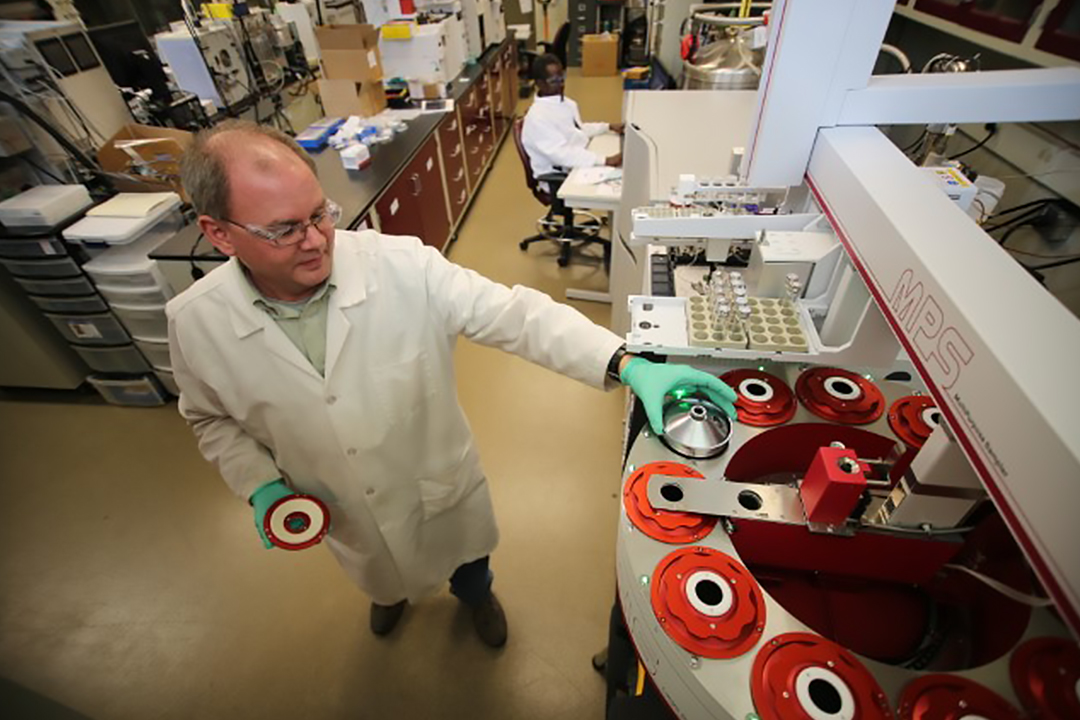// NEWS RELEASE
ECBC Researchers Combine Wearable Sensors, Advanced Mass Spectrometry to Gather Life-Saving Information
CCDC Chemical Biological Center Public Affairs | May 4th, 2018
ECBC Researchers Combine Wearable Sensors, Advanced Mass Spectrometry to Gather Life-Saving Information
DEVCOM CBC Public AffairsMay 4th, 2018

U.S. Army Edgewood Chemical Biological Center research chemist Bruce King, Ph.D., loads samples into the GCxGC HRTOF system.
Scientists at the U.S. Army Edgewood Chemical Biological Center (ECBC) are combining wearable chemical samplers and multi-dimensional chromatography to enhance Soldier protection by accurately identifying which and how much chemical warfare agent a Soldier has been exposed to.
Soldiers and first responders who perform sensitive site exploitations frequently enter areas containing unknown chemicals at varying toxic concentrations as part of their jobs. The handheld detectors used for these tasks are susceptible to false alarms, may have a limit of detection higher than the amount present, or may not accurately identify the chemical class of present compounds.
If a Soldier is potentially exposed to a chemical warfare agent, even at sub-lethal amounts, it is a race against time to obtain samples and identify the agent, often in a background of dozens or even hundreds of other compounds. Sub-lethal amounts of agent could produce symptoms that can be misdiagnosed as other common illnesses, so it is important to know what chemical warfare agents are involved in order to provide the correct medical countermeasure. ECBC’s new method will improve accurate identification.
First, the wearable sampler clips on to a Soldier’s uniform and collects information about various substances that the Soldier may have been exposed to during a mission.
“The sampler collects almost everything it encounters,” said Bruce King, Ph.D., ECBC research chemist and project lead.
The samples collected will reflect the Soldier’s day-to-day movements. The sampler is sensitive enough to collect the residue of soap the Soldier showered with, and analysis of the sample can reveal data such as whether the Soldier has recently fueled or operated gas- or diesel-powered equipment, and whether the Soldier has been exposed to any chemical warfare agents.
Then, ECBC researchers use the LECO Corporation Pegasus GCxGC-High Resolution Time of Flight (HRTOF) system to analyze the data gathered in the sampler and accurately identify the chemical warefare agents.
“In order for us to be able separate and identify potentially thousands of compounds in a single sample, we utilize multidimensional gas chromatography coupled to a high resolution time of flight mass spectrometer. The system provides the separation and spectral resolution to pull characteristic peaks apart for differential analysis unavailable in field deployable systems. GCxGC-HRTOF has the ability to perform targeted analysis of threat list compounds and precursors with the confidence that a high-resolution mass spectrometer provides, in addition to untargeted analysis that could identify a link between clandestine labs, which is unparalleled,” said King.
ECBC has already deployed several wearable samplers to Soldiers outside of the continental U.S., and researchers are working toward optimizing the form factor of the sampler. Additionally, ECBC researchers are using data collected from the deployed samplers to determine the most effective selection methods to analyze samples for early warning and attributions of waterborne chemical hazards. This research could lead to the ability to determine the source of chemical warfare agent release and identify global trends in use of emerging threats.
The U.S. Army Combat Capabilities Development Command (DEVCOM) leads in the discovery, development and delivery of technology-based capabilities to enable Soldiers to win our nation’s wars and come home safely. DEVCOM is a major subordinate command of the U.S. Army Futures Command. The DEVCOM Chemical Biological Center is the Army’s principal research and development center for chemical and biological defense technology, engineering and field operations. The DEVCOM Chemical Biological Center is headquartered at Aberdeen Proving Ground, Maryland.
